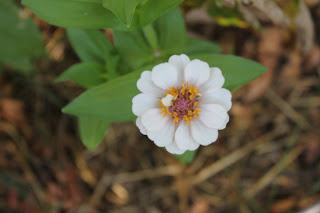I gathered two garden cart-fulls of leaves from the front yard, dragged them to the back yard compost bin, and mixed it into our current compost. Later I added another cart-full of leaves just for good measure.
In the meantime, Aaron prepared the garlic bed. I try to avoid tilling whenever possible so we can have some nice, fluffy soil full of worms...which means prepping a bed is hard work. I did help, a little. We sifted 12 buckets of finished compost to add to the bed, which I then raked in and smoothed the soil. Time for the garlic! Last year I planted 3 rows in my 4' x 16' beds. I realized I could have planted them closer together, and I finalized that decision after seeing that Daphne planted her garlic in a 6" grid. Fun fact: The holes in the leftover trellis material sitting in our garage are exactly 3" apart—perfect spacers!
Last year I planted about 95 cloves of garlic (and I think I paid about $40 for the seed), and I'm quite sure I won't have enough to get us through until next year's harvest. So, I planted 119 cloves this year (trying to strike a balance between planting more but leaving some for our use). I chose the largest cloves from last year's harvest. The Music cloves are amazing - I planted 63 of those. The Spanish Roja are much less impressive, but since I had them, I planted 56 cloves. Because I planted in a grid instead of in rows, I managed to use about half as much space, even though I planted about 20% more than last year.
The difference in the soil quality between last year and this year is remarkable. Last year I had to dig holes and shove the garlic cloves into the cold earth in between clods of clay soil. This year, I could push the cloves a few inches into the soil and cover them without tools in most cases. The compost has been doing its job :)
To finish, I brought another cart-full of leaves from the front yard, crunched them up a bit, and used them to mulch the garlic. Aaron watered it in, and now we'll just sit back and wait for spring.
Also, Aaron bought some 7mil plastic to put over our bed of chard, carrots and beets. This is our first year using hoops, so it's really just an experiment - but I'll be very excited if I can harvest chard throughout the winter, and carrots and beets in early spring.

.JPG)




























































